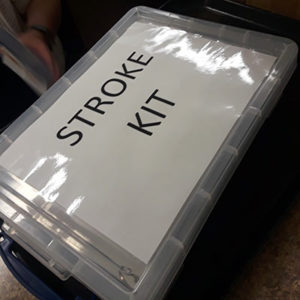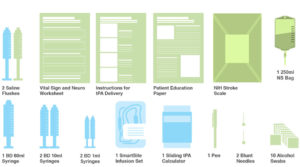
Enhancing stroke care
For every minute an individual suffers from a stroke, 1.9 million brain cells die. So it stands to reason that time is of the essence when treating this medical emergency. With that in mind, the Stroke Clinical Improvement team for OSF HealthCare made it a priority for every hospital within the Ministry to deliver a drug called tPA within 45 minutes of an ischemic stroke patient arriving to the emergency department (ED).
The team enlisted the Solution Design and Integration (SDI) team, that includes representation from Quality and Safety, Performance Improvement (PI), Clinical Integration, Clinical Excellence, Institute of Learning and Ministry Education to carry out this goal. The multidisciplinary collaborative is charged with developing solutions for important clinical initiatives within the span of 20 business days, using human centered design-thinking, innovation, PI and agile tools.
Over the course of 15 days, SDI collaborated with patients, volunteers and ED clinicians to create an easily accessible stroke kit that can be used at every facility. This ensures patients receive the highest level of care no matter what hospital they go to.
Speeding up tPA delivery times
As with many process improvements that have taken place across the Ministry, SDI first had to standardize the way medication and treatment for stroke is given. Many facilities had their own policies and procedures around this practice.
The team also interviewed patients about their experience receiving stroke care and talked with clinicians about their roles to understand all facets of the treatment process. From there, SDI presented their research to subject matter experts and together came up with a variety of ideas to improve tPA delivery times.
The result is the creation of a stroke kit that includes all of the same equipment, tools and supplies clinicians need to treat a patient for the medical emergency—placed in a centralized location at every OSF HealthCare hospital. The idea is that tPA can be administered to a person the moment they are diagnosed with a stroke, even if they are on the Computed Tomography (CT) table. The kit also includes a standard screening tool and one-sheet document with big pictures and few words to educate patients and their families of what’s taking place.
As part of the solution, SDI determined nurses should be responsible to reconstitute tPA to patients as it’s within their scope of practice and reduces delivery time by 10 to 15 minutes. The team also suggested the ED call a stroke alert as soon as they learn of a patient coming in by ambulance with symptoms.
Stroke kit performance

The stroke kit was first tested at OSF HealthCare Heart of Mary Medical Center in Champaign and OSF HealthCare Sacred Heart Medical Center in Danville. Both facilities were able to shave off 20 minutes of time in administering tPA to stroke patients. The kit was tested in two more hospitals before being approved in March for Ministry-wide implementation. It is now being used in every OSF emergency department.
Placing patients at the center of this work has been invaluable in designing the stroke kit. Meeting the goal of treating ischemic stroke patients within 45 minutes of them arriving to the hospital will improve a patient’s chance of survival and reducing preventable disability.
